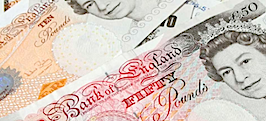The debt of the UK government was £2.388 trillion at the end of July 2022 — an increase of £188.4 billion compared with July 2021 — according to the latest figures from the UK’s Office for National Statistics (ONS).
The ONS said the £2.388 trillion public sector net debt excluding public sector banks (PSND ex) was around 95.5% of gross domestic product (GDP), an increase of 1.4 percentage points of GDP compared with July 2021.
Central government debt interest payable was £5.8 billion in July 2022, £2.3 billion more than in July 2021 but £13.9 billion less than the record £19.7 billion payable in June 2022.
The volatility in interest payable is largely because of the effect of Retail Prices Index (RPI) changes on index-linked gilts.
UK public sector net borrowing excluding public sector banks (PSNB ex) was £4.9 billion in July 2022 — £0.8 billion less than in July 2021 but £5.9 billion more than in pre-pandemic July 2019.
Central government day-to-day expenditure increased compared with July 2021 by £3.4 billion to £76.5 billion, with a £2.3 billion increase in debt interest payable and a £2.8 billion increase in net social benefit payments being partially offset by a £1.5 billion reduction in subsidy payments.
Central government receipts were £78.2 billion in July 2022 — £6.1 billion more than in July 2021 — and of this, tax receipts were £58.6 billion, an increase of £4.6 billion compared with July 2021.
The Office for Budget Responsibility (OBR), a UK government agency, said: “The budget deficit continues to fall year on year, with April-to-July borrowing of £55.0 billion down £12.1 billion on last year.
“But it was £3.0 billion above our March forecast profile, largely reflecting higher spending.
“Sharp rises in inflation continue to raise debt interest costs by even more than our forecast assumed, while the cost-of-living payments to means-tested benefit recipients – announced in May, so not reflected in our March forecast – began last month.”
